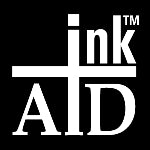Applying and Working with inkAID Coatings
Q. How do I work with inkAID coatings?
A. It's as easy as applying the coating, drying, and printing!
Always work with clean tools and brushes.
inkAID coatings are usually applied with a foam brush or good quality bristle brush. It's important to apply a sufficient amount of wet coating to the substrate for good printability. When starting out, perform a few "test applications" on new substrates to determine the optimum amount of coating required. A good practice is to apply the wet coating in one direction and then apply it again at a 90 degree angle. You could also use a stainless steel coating rod, or a Paasche VLS Airbrush. Allow the coating to dry completely, usually overnight, before printing. Some papers will curl slightly after drying so be sure to flatten your substrate before printing.
Q. Should inkAID coatings be stirred before using?
A. Yes. Using a clean metal spatula or mixing spoon stir all inkAID coatings gently but thoroughly from the bottom of the container. Don’t shake the bottles, doing so may incorporate air bubbles that may dry on your substrate and disrupt the smoothness of the final coat. Pour the coating into a working container and use all of it. Don't pour used coating back into the container.
Q. How do I clean up inkAID coatings.
A. inkAID coatings are water based and easy to clean up with moderately hot water. The inkAID White Matte, Translucent Gloss, and Adhesive Primer coatings are extremely water resistant so clean any containers, tools, and brushes promptly after use.
Q. How can I flatten and smooth out a porous substrate such as paper after coating with inkAID?
A. The normal reaction of porous substrates, like paper, is to absorb water and swell. This will cause the substrate to slightly buckle and curl upon drying. To reduce the amount of curl, the substrate can be hung from a thin wire (using metal clips or clothespins) after coating, allowing gravity to pull down and remain flat as it dries. Additional metal clips can be placed to the bottom of the hanging substrate to add additional weight. If the substrate is still curled after drying, it can be pressed flat using several methods. One is to place it between two flat pieces of material such as plexiglas and loading a heavy weight upon it overnight or for a few days. Another method is to place the substrate between several pieces of parchment or wax paper and using a moderately hot iron or heat press to remove the curl. Yet another method is to hold the top and bottom of the substrate with both hands and gently run it over the smooth edge of a table or countertop.
